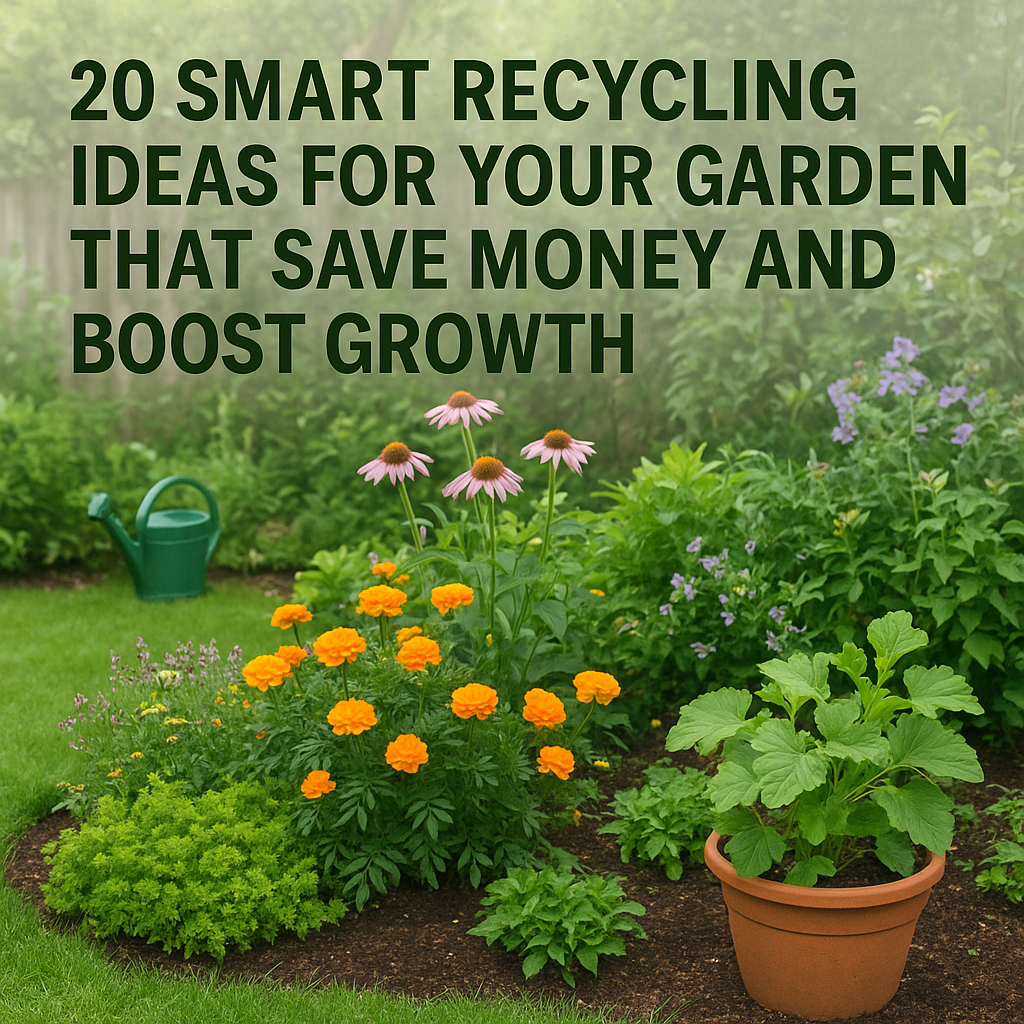Gardening doesn’t have to be expensive or complicated—you can create a thriving, eco-friendly garden with items you already have at home. From kitchen scraps to everyday household supplies, many of the things we usually toss in the trash can actually improve soil health, fight pests, and help plants grow stronger. These clever recycling hacks not only save money but also cut down on waste, making your garden more sustainable. Whether you’re a seasoned gardener or just starting out, these 20 ideas will show you how simple changes can make a big difference.
1. Coffee Grounds as Natural Fertilizer
If you’re a coffee drinker, don’t throw away those used grounds. They’re packed with nitrogen, which plants love. Just sprinkle them into the soil or mix them into your compost pile. The grounds also improve soil texture, keeping it loose and airy, which roots really appreciate. Plus, earthworms seem to be coffee fans too, and having more worms in your garden is always a good sign. Next time you brew your morning cup, save the leftovers for your plants—it’s like a wake-up call for your garden too.
2. Banana Peel Boost for Roses
Banana peels aren’t just kitchen scraps—they’re basically plant vitamins in disguise. Bury a peel near the base of your rose bushes, and over time it breaks down, releasing potassium and phosphorus. These nutrients help roses put out stronger roots and more vibrant blooms. If you’ve ever admired a neighbor’s rose garden, this little trick might just help yours compete. I once tried it on a struggling rose bush, and within a few weeks, the difference was so obvious that I’ve never thrown a peel in the trash again.
3. DIY Citrus Peel Seed Starters
Instead of buying seedling trays, try using citrus peels. Just scoop out the inside of an orange or lemon half, poke a tiny hole in the bottom for drainage, and fill it with potting soil. Once your seeds sprout, you can plant the entire thing in the garden. The peel decomposes naturally, giving your plants a nutrient boost right from the start. I like this method because it feels like zero waste—you get a snack and a seed starter in one go.
4. Epsom Salt for Greener Leaves
If your plants are looking a little dull or yellow, they might be craving magnesium. Mix a tablespoon of Epsom salt with a gallon of water and use it to water or spray your plants. The magnesium helps with chlorophyll production, giving leaves that deep green color. It also encourages more flowers and fruit. I keep a small container of Epsom salt handy in my shed, and honestly, it’s saved a few tomato plants that were looking pretty sad.
5. Cinnamon Powder to Prevent Mold
Cinnamon isn’t just for baking—it’s a secret weapon for gardeners too. Sprinkle a little on your soil or over seedlings, and it acts as a natural antifungal. This helps prevent damping-off, that frustrating disease where young plants just collapse overnight. The first time I tried this trick, I was skeptical, but it kept my delicate basil seedlings safe when I usually lose half of them. Now I always keep a jar of cinnamon in my gardening kit.
6. Milk Spray Against Powdery Mildew
Got that white, powdery stuff on your plants’ leaves? That’s powdery mildew, and it can spread fast. A simple fix is mixing one part milk with nine parts water and spraying it directly on the leaves. The proteins in milk actually fight the fungus, and as a bonus, plants get a little nutrient boost. I once used this on my zucchini plants, and within a few days the leaves looked much healthier—it’s like giving them a homemade immune shot.
7. Vinegar for Weed Control
Weeds popping up in garden paths or between patio cracks can be a real pain. Instead of using chemical sprays, grab some vinegar and spray it directly on the weeds. The acidity dries them out and kills them naturally. Just be careful not to spray your actual plants, because vinegar isn’t picky—it’ll hurt them too. I keep a spray bottle handy for driveway cracks, and it works like a charm after a sunny afternoon.
8. Soap and Water Pest Spray
Aphids, spider mites, and other tiny pests love sneaking onto your plants, but they hate soap. Mix a few drops of liquid soap in a spray bottle with water, and spritz it on the leaves where pests are hanging out. The soap breaks down their protective coating and sends them packing. I once saved a batch of basil this way after it was swarmed with aphids, and it bounced back beautifully within a week.
9. Plastic Bottle Drip Irrigation
If you don’t have time to water every day, a recycled plastic bottle can do the job for you. Just poke a few small holes in the sides, bury it near the roots of your plant, and fill it with water. The bottle slowly releases moisture, keeping the soil consistently damp. I’ve used this trick when going away for the weekend, and it kept my tomato plants happy and hydrated without me hovering around.
10. Newspaper Mulch for Weed Prevention
Weeds love sunlight, so cutting it off is the easiest way to stop them. Lay a few sheets of newspaper around your plants, then cover with mulch. The paper blocks light, smothers weeds, and eventually breaks down into the soil as organic matter. I tried this in my vegetable bed, and not only did it save me from endless weeding, but the soil looked richer by the end of the season.
11. Garlic Spray to Repel Pests
If bugs are munching on your plants, garlic can come to the rescue. Blend a few cloves with water, strain the mix, and spray it directly on your plants. The strong smell keeps away aphids, caterpillars, and even some beetles. I tried this on my kale after caterpillars started making holes, and it worked so well that I didn’t have to reach for anything stronger.
12. Wooden Spoon Plant Markers
Instead of buying plant labels, repurpose old wooden spoons. Paint them or just write the plant names on the handle, then stick them into the soil. They last longer than paper tags and give the garden a fun, homemade touch. I once used mismatched spoons from the back of my kitchen drawer, and they ended up making the veggie patch look surprisingly charming.
13. Leftover Tea for Acid-Loving Plants
Don’t pour out that leftover tea—it’s great for plants that love acidic soil, like blueberries, azaleas, or ferns. Just let it cool and water it into the soil. The tannins and nutrients enrich the ground and give your plants an extra boost. I noticed my fern looking perkier after I gave it a tea “drink,” and now I save every unfinished cup.
14. Baking Soda for Sweeter Tomatoes
Want tomatoes that taste less tangy and more sweet? Sprinkle a little baking soda around the base of your tomato plants. It lowers soil acidity, which helps the fruit develop a milder, sweeter flavor. The first time I tried this, I was skeptical, but the difference in taste was clear—it made my summer tomato salads that much better.
15. Reuse Toilet Paper Rolls for Seedlings
Those cardboard rolls from toilet paper can be perfect seed starters. Cut them into smaller sections, fill with soil, and plant your seeds. When the seedlings are ready, you can transplant the whole roll directly into the garden, and it breaks down naturally in the soil. I love this method because it’s practically free and keeps waste out of the trash.
16. Crushed Nut Shells as Mulch
Instead of tossing nut shells in the trash, put them to work in your garden. Crushed walnut, pecan, or peanut shells make excellent mulch, helping soil hold moisture while adding a unique texture to garden beds. They also slowly break down, enriching the soil. I once used a pile of peanut shells from a family barbecue, and they kept the soil moist far longer than expected.
17. Rainwater Collection for Irrigation
Why let all that rainwater run off when your plants could use it? Set up a barrel or container under your roof gutter to collect rainwater. It’s free, chlorine-free, and much gentler on plants than tap water. I started doing this during a dry summer, and the difference in how my veggies thrived was so noticeable that I’ve never gone back.
18. Apple Cider Vinegar for Acidic Plants
Some plants—like hydrangeas, azaleas, and rhododendrons—love acidic soil. You can easily give them what they need by mixing a tablespoon of apple cider vinegar into a gallon of water and pouring it around the base of the plant. I’ve done this with my hydrangeas, and the blooms came out more vibrant than ever.
19. Companion Planting with Marigolds
Marigolds aren’t just pretty—they’re natural bodyguards for your garden. Their scent helps repel nematodes and pests, while their bright flowers attract bees and other pollinators. Plant them near your vegetables, and you’ll notice fewer bugs and better harvests. I always tuck a few marigolds in my tomato bed, and it feels like having tiny golden protectors.
20. Recycled Pallet Vertical Garden
Got an old wooden pallet lying around? With a little creativity, you can turn it into a vertical garden. Add soil pockets, plant herbs or flowers, and lean it against a wall or fence. It’s a space-saver, especially for small patios or balconies. I once grew a full herb garden this way, and it made my outdoor space look like something out of a design magazine.
The best part about these garden hacks is how easy and practical they are. By reusing everyday items like coffee grounds, banana peels, or even toilet paper rolls, you’re giving your plants natural care while keeping waste out of the landfill. Small steps like these add up, and before long, you’ll notice healthier soil, stronger plants, and fewer chemicals in your garden. Try a few of these ideas the next time you’re in the yard—you might be surprised by how much your garden (and your wallet) thanks you.


